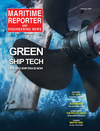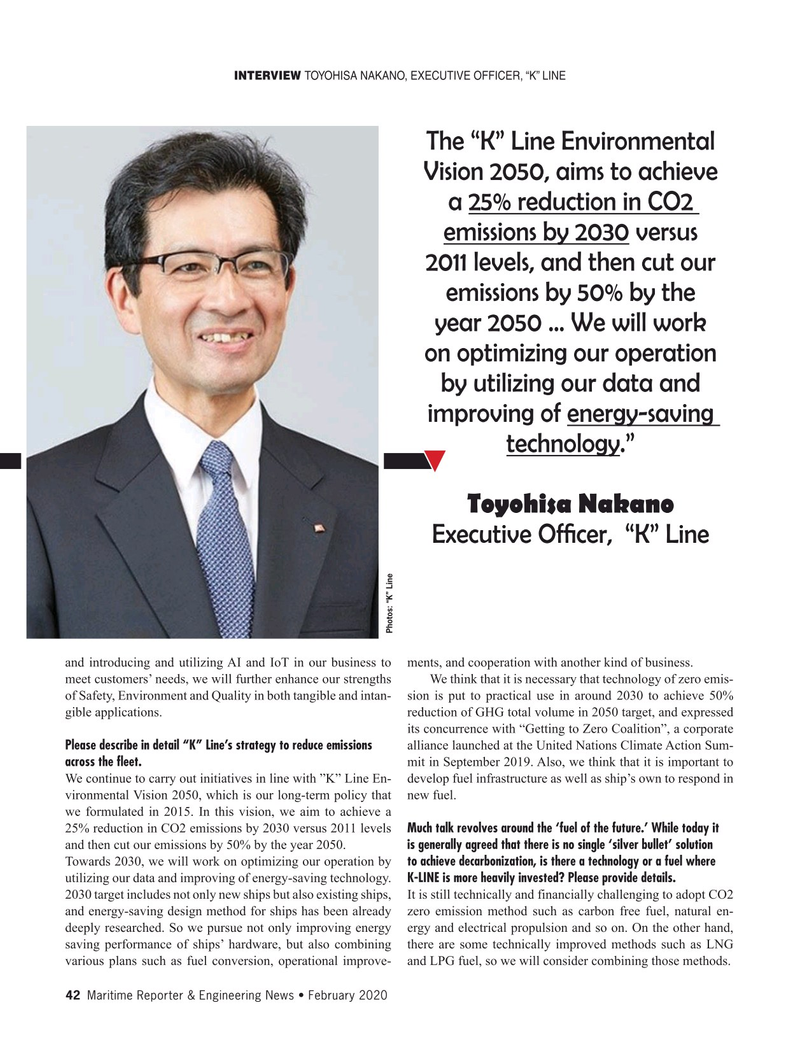
Page 42: of Maritime Reporter Magazine (February 2020)
Green Ship Technology
Read this page in Pdf, Flash or Html5 edition of February 2020 Maritime Reporter Magazine
INTERVIEW TOYOHISA NAKANO, EXECUTIVE OFFICER, “K” LINE
The “K” Line Environmental
Vision 2050, aims to achieve a 25% reduction in CO2 emissions by 2030 versus 2011 levels, and then cut our emissions by 50% by the year 2050 ... We will work on optimizing our operation by utilizing our data and improving of energy-saving technology.”
Toyohisa Nakano
Executive Of? cer, “K” Line
Photos: “K” Line and introducing and utilizing AI and IoT in our business to ments, and cooperation with another kind of business. meet customers’ needs, we will further enhance our strengths We think that it is necessary that technology of zero emis- of Safety, Environment and Quality in both tangible and intan- sion is put to practical use in around 2030 to achieve 50% gible applications. reduction of GHG total volume in 2050 target, and expressed its concurrence with “Getting to Zero Coalition”, a corporate
Please describe in detail “K” Line’s strategy to reduce emissions alliance launched at the United Nations Climate Action Sum- across the fleet. mit in September 2019. Also, we think that it is important to
We continue to carry out initiatives in line with ”K” Line En- develop fuel infrastructure as well as ship’s own to respond in vironmental Vision 2050, which is our long-term policy that new fuel.
we formulated in 2015. In this vision, we aim to achieve a 25% reduction in CO2 emissions by 2030 versus 2011 levels Much talk revolves around the ‘fuel of the future.’ While today it and then cut our emissions by 50% by the year 2050. is generally agreed that there is no single ‘silver bullet’ solution
Towards 2030, we will work on optimizing our operation by to achieve decarbonization, is there a technology or a fuel where utilizing our data and improving of energy-saving technology. K-LINE is more heavily invested? Please provide details.
2030 target includes not only new ships but also existing ships, It is still technically and financially challenging to adopt CO2 and energy-saving design method for ships has been already zero emission method such as carbon free fuel, natural en- deeply researched. So we pursue not only improving energy ergy and electrical propulsion and so on. On the other hand, saving performance of ships’ hardware, but also combining there are some technically improved methods such as LNG various plans such as fuel conversion, operational improve- and LPG fuel, so we will consider combining those methods. 42 Maritime Reporter & Engineering News • February 2020
MR #2 (34-49).indd 42 2/5/2020 11:34:51 AM

 41
41

 43
43
